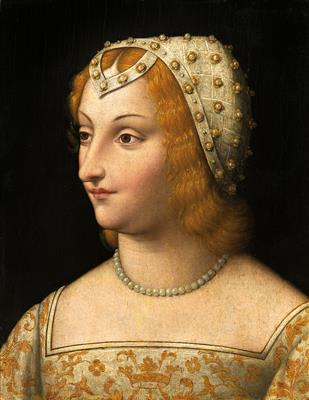Venetian School, 16th century

Petrarch’s Laura,
oil on panel, 31.7 x 24 cm, framed
Numerous copies and variants, either painted, illuminated or printed, are known to exist of Petrarch’s Laura. Possibly one of the oldest known likenesses is the celebrated miniature in the Medici Codex (Codice Mediceo Laurenziano, Plut. 41.1, c. IX), which was executed before the end of the 15th century. The existence of a presumed 14th century portrait of Laura executed by Simone Martini is suggested by Vasari, as well by the references that Petrarch himself made to it in two of his sonnets. According to a time-honoured tradition, the profile of the princess appearing in the fresco depicting Saint George Saving the Princess on the façade of the Avignon Cathedral (although the fresco was destroyed in 1828, a 17th-century drawing of it still exists: Rome, Bibl. Vaticana, cod. Barb. lat. 4426), executed by Simone Martini himself in the years 1340-43, can be regarded as a portrait of Laura. As a result of the aforementioned tradition, an iconographic type of Laura’s image gradually established itself. Its constant characteristics are, besides her blond hair (in accordance with Laura’s physical description dating back to Petrarch), her delicate features and the type of clothing consisting of a brocade dress with vine branch patterns and a bonnet embellished with gems or pearls and a similarly gem-studded pendant gracing her forehead.
The majority of known portraits of Laura date back to the 16th century, their style mostly suggesting a provenance from the northern Italy. The development of an interest in the genre of portrait painting between the 15th and 16th centuries and, above all, the revival that Petrarch and his Canzoniere enjoyed in cultivated society throughout Europe were probably responsible for an increase in the demand for replicas of the presumed portrait of Laura. As is well documented in the sources, both Pietro Aretino and Benedetto Bembo owned a version of it.
The present painting is both stylistically and iconographically very similar to another version, also on panel, currently preserved at the National Gallery in Prague (from Prague Castle: inv. O. 238; cm 34 x 23.5). The similarities are above all stylistic, but they also concern the figure’s physiognomy as well as details of the dress and the hairstyle, with the exception of a pearl necklace that is wrapped around the woman’s neck not in one, but three lines in the Prague version. These similarities seem to suggest their provenance from one and the same artistic environment, see the16th-century Italian School in the catalogue of the National Gallery in Prague, edited by O. Pujmanovà/ P. Pribyl (Italian Paintings c.1330-1550 I. National Gallery in Prague. II Collections in the Czech Republic. Illustrated Summary Catalogue, Prague 2008, pp. 306–307).
09.04.2014 - 18:00
- Odhadní cena:
-
EUR 40.000,- do EUR 60.000,-
Venetian School, 16th century
Petrarch’s Laura,
oil on panel, 31.7 x 24 cm, framed
Numerous copies and variants, either painted, illuminated or printed, are known to exist of Petrarch’s Laura. Possibly one of the oldest known likenesses is the celebrated miniature in the Medici Codex (Codice Mediceo Laurenziano, Plut. 41.1, c. IX), which was executed before the end of the 15th century. The existence of a presumed 14th century portrait of Laura executed by Simone Martini is suggested by Vasari, as well by the references that Petrarch himself made to it in two of his sonnets. According to a time-honoured tradition, the profile of the princess appearing in the fresco depicting Saint George Saving the Princess on the façade of the Avignon Cathedral (although the fresco was destroyed in 1828, a 17th-century drawing of it still exists: Rome, Bibl. Vaticana, cod. Barb. lat. 4426), executed by Simone Martini himself in the years 1340-43, can be regarded as a portrait of Laura. As a result of the aforementioned tradition, an iconographic type of Laura’s image gradually established itself. Its constant characteristics are, besides her blond hair (in accordance with Laura’s physical description dating back to Petrarch), her delicate features and the type of clothing consisting of a brocade dress with vine branch patterns and a bonnet embellished with gems or pearls and a similarly gem-studded pendant gracing her forehead.
The majority of known portraits of Laura date back to the 16th century, their style mostly suggesting a provenance from the northern Italy. The development of an interest in the genre of portrait painting between the 15th and 16th centuries and, above all, the revival that Petrarch and his Canzoniere enjoyed in cultivated society throughout Europe were probably responsible for an increase in the demand for replicas of the presumed portrait of Laura. As is well documented in the sources, both Pietro Aretino and Benedetto Bembo owned a version of it.
The present painting is both stylistically and iconographically very similar to another version, also on panel, currently preserved at the National Gallery in Prague (from Prague Castle: inv. O. 238; cm 34 x 23.5). The similarities are above all stylistic, but they also concern the figure’s physiognomy as well as details of the dress and the hairstyle, with the exception of a pearl necklace that is wrapped around the woman’s neck not in one, but three lines in the Prague version. These similarities seem to suggest their provenance from one and the same artistic environment, see the16th-century Italian School in the catalogue of the National Gallery in Prague, edited by O. Pujmanovà/ P. Pribyl (Italian Paintings c.1330-1550 I. National Gallery in Prague. II Collections in the Czech Republic. Illustrated Summary Catalogue, Prague 2008, pp. 306–307).
|
Horká linka kupujících
Po-Pá: 10.00 - 17.00
old.masters@dorotheum.at +43 1 515 60 403 |
| Aukce: | Obrazy starých mistr? |
| Typ aukce: | Salónní aukce |
| Datum: | 09.04.2014 - 18:00 |
| Místo konání aukce: | Wien | Palais Dorotheum |
| Prohlídka: | 29.03. - 09.04.2014 |
